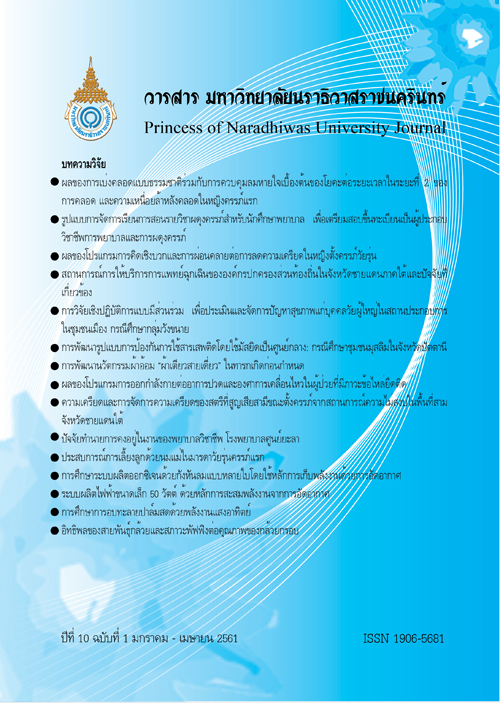Factors Predicting Job Retention of Professional Nurses at Yala Hospital
Keywords:
Factors predicting, Job retention, Professional nurseAbstract
This descriptive research aimed to examine job retention and factors predicting the job retention. The
samples of this study were 248 professional nurses working at Yala Hospital. The participants were conducted through simple random sampling.. The research instrument utilized in this study was a questionnaire. Content validity index was verified by three experts: IOC, yielding values of 0.92.. The reliability was verified by using Cronbach’s alpha coefficient, yielding values of 0.95.. The data were analyzed using mean, standard deviation, Pearson product moment correlation coefficient and stepwise multiple regression analysis.
The results of this study revealed that the personal factors related to a high level of job retention
were the responsibilities to nurture of their families (M=4.11, S.D.=0.88), their hometown or houses located
near by the hospital (M=4.07, S.D.=1.02). In addition, the organizational factors consisted of colleagues’ relationships (M=3.79, S.D.=0.72). The mean working duration of professional nurses working at Yala hospital was 10.13 years (S.D.=9.11). 73.4 percent thought they would like to continue their work until being retired. Moreover, age, hometown, perspectives, and income could predict the variance of the job retention of the nurses (87.3%). Therefore, these findings could be a significant guide for organizational administrators to set up policies and promote strategies to strengthen retention of quality professional nurses in order to meet effectivenursing services.
References
Herzberg, F. (1959). The Motivation of Work. New York: John Wiley & Sons.
Maslow, A. H. (1970). Motivation and Personality. (2nd ed.). New York: Harper & Row.
Mitchell, T. S., & Thomas, W. L. (2001). The unfolding model of voluntary turnover and job embeddedness:
Foundations for a comprehensive theory of attachment. Research in Organization Behavior, 23(1),189-246.
Sawaengdee, K. (2008). The Current Nursing Workforce Situation in Thailand. Journal of Health Systems Research, 2(1), 40-46. (in Thai).
Srisatidnarakul, B. (2008). Leadership and Strategic management in Nusing Organization for the 21th Century.
Bangkok: Chulalongkorn University. (in Thai).
Srisuphan, W. & Sawaengdee, K. (2012). Recommended Policy-based Solutions to Shortage of Registered
Nurses in Thailand. Thai Journal of Nursing Council 2012, 27(1), 5-12. (in Thai).
Steers, R. M. (1984). Introduction to Organizational Behavior. (2nd ed.). Illiois: Scott Foresman.
Tangchatchai, B., Siritarungsri, B., Sripunworasakul, S. & Rungkawat, V. (2011). Factors Predicting Job Retention of Professional Nurses at the Northeast Regional Hospitals, Ministry of Public Health. Thai Journal of Nursing Council, 26(4), 43-54. (In Thai).
Taokumlue, S. & Damapong, P. (2007). Selected Predictors of Nurses Intention to Remain with Organization,
Private Hospitals, Bangkok Metropolis. Journal of Nursing Science Naresuan University, 1(1), 92-105. (in Thai).
Thungjaroenkul, P., Swaengdee, K., Theerawit, T. & Tungcharoensathien, V. (2015). Health Problems and
Health Care Behaviors Among Registered Nurses in Thailand. Journal of Health Systems Research, 9(1), 49-60. (in Thai).
Wonganutrohd, P. (2004). Personnel Management Psychology. Bangkok: Pimdee. (in Thai).
Yospaiboon, K. (1995). A Study on Factors Affecting Professional Nurse Retention in Srinagarind Hospital, Khonkaen University. Master’s Thesis. Khonkaen University. (in Thai).



